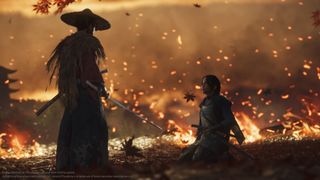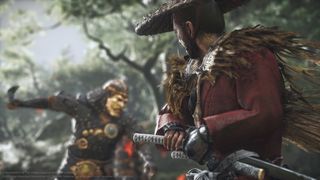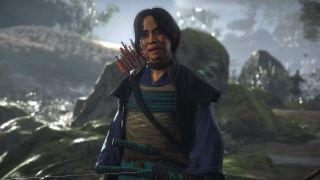Sucker Punch has put so much thought into the tiniest details of Ghost of Tsushima that it kinda makes me want to cry
Sucker Punch has put so much care into the smallest details in Ghost of Tsushima, and it’s already paying off.
The first thing I’m told about the Ghost of Tsushima is that it wants us to feel like we’re in a time machine. I won’t lie to you, for a split second I’m sceptical. This isn’t the first game set in the past (hello, Assassin’s Creed: Odyssey), and it won’t be the last. But then the demo starts playing, and studio co-founder Chris Zimmerman starts to explain all the thought that’s gone into bringing Tsushima to life with an earnest eagerness that I simply can’t admire enough. Then I start to get emotional. Because my god, Sucker Punch care about this game so much that it’s gone above and beyond to get ancient Japan exactly right.
Let’s start with something that might initially make you yawn: the weather. No, I’m not going to start some crap small talk. Instead let me tell you how the team at Sucker Punch has developed procedural weather generation, where everything from the clouds to just how much sunlight filters through them, to the wind, to the grass swaying in the breeze, is all algorithmic and constantly evolving so you’ll never encounter the same exact environment twice. Filmmaker Akira Kurosawa of Seven Samurai fame was a huge influence on the look of Ghost of Tsushima, with the continuous motion in the background being a key feature of his movies that Sucker Punch wanted to bring to life. It’s not just meant to look stunning, though: when you look in the distance as the samurai Jin and see Mongol ships in the bay, or a raging fire burning in the distance, you can go find out what’s happening over there. It’s about as open world as it gets, but in the demo we’ve all seen Jin is heading to save a monk from getting murdered by the Mongols.

It doesn’t look like those Mongols stand much of a chance against Jin. Taking down that first soldier that approaches him with a slash of his sword, the moment when he unsheathes it from the scabbard is a button press, meaning that it must be some kind of devastatingly powerful opening combat move. At this the demo was paused, with the camera panning to show the blood splatter frozen in mid air in a deadly arc. Each droplet is tracked separately, so were Jin to waste seconds looking at the mud he’d see where that blood was spilt before his own joined it in the dirt. The combat isn’t the only thing that’ll have you believing that you’re in ancient Japan. Sucker Punch even sent someone to Japan just to record the sounds of the wild, from the birds in the air to the sound of the trees brushing against each other. It’s all there to sell you on that idea of the time machine, that you’re stepping back in time to a world that’s now within reach.
Just like the ever-changing dynamic weather, things are also constantly in flux for Jin. After being brought up to abide by a specific samurai code that demands he face his enemies head-on, state his lineage, and bring forth a challenger, Jin has to throw all that away in order to get the upper hand on the ruthless Mongols. When he drops down from the roof of the temple into the middle of no less than three Mongols, everything switches into slow-motion like Red Dead Redemption’s Dead Eye as he takes down one after the other with deadly katana slashes, so I’m betting that’s a special skill you power up to unleash when things get tough. Which they will, by the way. Because Ghost of Tsushima is tough - so tough, in fact, that it’s been toned down for the demo.

Sucker Punch wants you to feel scared. It wants you to feel outnumbered, so even though the Mongols taunted you for a bit longer in the demo they won’t hesitate in the actual game. Prepare to feel the conflict samurai are going through too, as by the sounds of it you’ll start off with certain traditional skills and then have to rework them to suit the stealthier, more tactical approach to taking out the invaders. At one point Zimmerman even says that Jin will be dead in seconds if he lets his guard down, so Ghost of Tsushima is going to push you to your limit to reflect Jin’s relatively weak armour and slight build. Not everything will come in flurries, as Zimmerman mentions that there’s a natural ebb and flow to combat with pauses inherent to the rhythm of fighting, as enemy AI sizes you up and you do the same in return. The Mongols even have a special taunt behaviour that you can use to your advantage. While they’re busy yelling, you’ll be busy planning.

Combat was developed alongside a student of martial arts - Sucker Punch won’t say which one so we don’t make any comparisons - who is by the sounds of it part of has a pedigree lineage when it comes to fighting. A similar amount of care is being paid to the voicing of Ghost of Tsushima, as discussions are currently ongoing about whether to have an alternate voicing of the entire game in Japanese with English subtitles, which was tried out for the demo that I saw and worked profoundly well. If that wasn’t enough, the team also visited the Komodahama Shrine festival that commemorates the soldiers who fought the Mongols and handed out their cards to the organisers...then spent a whole year terrified that Ghost of Tsushima would leak.
By the end of the demo, I was left completely believing in the Time Machine. Everything melts away when it’s on screen; a combination of the gentle breeze, the distant sound of birdsong and the rustling of Jin’s armour lulls you into truly believing that you are a samurai. Ghost of Tsushima tracks the Japanese as they try to find their path to survival, and you’d better hope that you find your own way too.
Sign up to the 12DOVE Newsletter
Weekly digests, tales from the communities you love, and more
While here at GamesRadar, Zoe was a features writer and video presenter for us. She's since flown the coop and gone on to work at Eurogamer where she's a video producer, and also runs her own Twitch and YouTube channels. She specialises in huge open-world games, true crime, and lore deep-dives.
Most Popular



